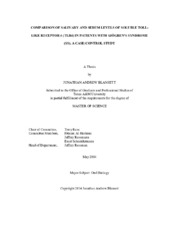| dc.description.abstract | Sjögren’s syndrome (SS) is an auto-immune (AI) mediated destruction of the
major and minor salivary glands, and is the second most common AI disease in the
United States. Typical treatment palliative in nature and no treatment is available that
will reverse or halt the progression of the disease process.
SS poses many dental problems for affected patients due to a loss of the
protective effects of the saliva, resulting in increased caries incidence. However,
whether SS patients are more at risk for periodontal disease is controversial. Periodontal
disease is a gram-negative bacterial infection that may or may not elicit an immune
response resulting in the destruction of the attachment apparatus of the teeth.
Toll-like receptors (TLRs) are highly conserved pattern recognition receptors
found throughout the body. TLR4 recognizes lipopolysaccharide (LPS) on gram
negative bacteria, and is involved in mucosal immunity. Many in vitro studies have
reported an increased expression of TLR4 in both SS and periodontal disease. Whether
or not TLR4 is a contributor to the induction and/or progression of SS and/or periodontal
disease is unknown.
This cross-sectional study examined potential differences in concentration of
TLR4 in serum and citric acid-stimulated saliva from patients with SS and healthy age-,
sex-, and periodontal disease matched control patients.
Salivary function was stimulated with 5.0 mLs of 2% citric acid, and whole
saliva samples were obtained. Full-mouth clinical periodontal measurements were
recorded from 21 SS patients and 22 control patients. Salivary and plasma TLR4 concentrations were determined by enzyme-linked immunoassays in 20 patients per study group. Collected data was statistically analyzed for its respective distribution.
No statistical differences in age, body mass index (BMI), salivary TLR4 concentrations, or clinical periodontal measurements were evident between either group. Salivary flow rates were significantly lower (P<0.001) whereas plaque % (p=0.048) and serum TLR4 concentrations (p=0.011) were significantly higher in SS patients.
The present findings support a hypothesis that a hyper-inflammatory systemic state, as seen in SS patients, can independently raise serum TLR4 concentration in the absence of periodontal disease and may be important in the induction and / or progression of SS-mediated pathophysiology in affected patients. | en |


